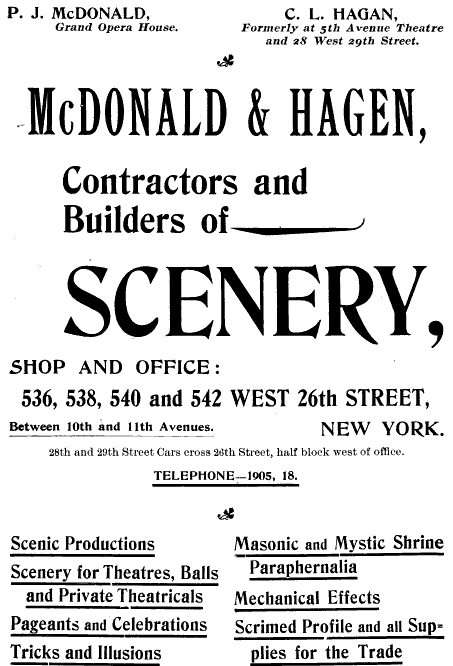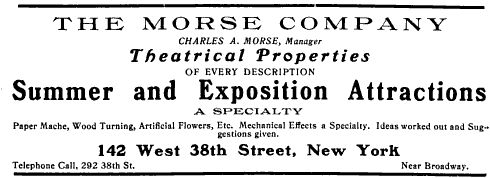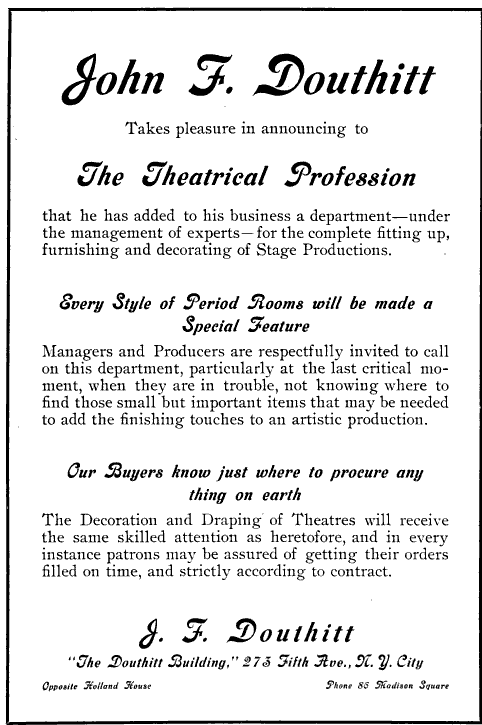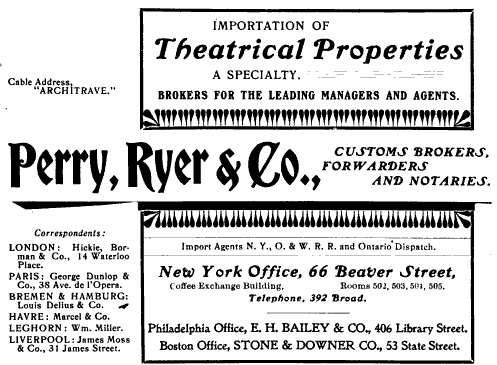A lot of ink has been spilled over what the proper definition of “props” would include. Many arguments try to deal with specific items—is a parasol a prop? A dog? I think props can be more easily defined once we realize there are two different ways of thinking on the subject: the academic way, and the practical way. The academic way is useful in terms of script and production analysis, while the practical way is useful when planning a production.
The Academic Way
One of the more pivotal books in our contemporary understanding of props is Andrew Sofer’s The Stage Life of Props. In it, Sofer says, “a prop can be more rigorously defined as a discrete, material, inanimate object that is visibly manipulated by an actor in the course of performance.”
He uses this definition to state that an object on stage must be “triggered” by an actor before it becomes a prop. He says “Thus a hat or sword remains an article of costume until an actor removes or adjusts it, and a chair remains an item of furniture unless an actor shifts its position.” This definition demands that an “actor-object interaction” is necessary for a prop to exist: “Irrespective of its signifying function(s), a prop is something an object becomes, rather than something an object is.” [ref]Andrew Sofer, The Stage Life of Props, (Ann Arbor: University of Michigan Press, 2003), 11-12.[/ref]
He draws some of his theory from Francis Teague, who described a property as “an object, mimed or tangible, that occurs onstage, where it functions differently from the way it functions offstage.” He elaborates on the idea of function (or “dislocated function”, as he calls it) further:
The property has a function, but it is not the same function as it has offstage (though it may imitate that ordinary function). The ordinary function of the object does not disappear; an object has the same connotation that it has offstage, for example. A knife might connote passion or violence when it appears onstage, but it will not function to injure anyone and may even be physically modified (by blunting or a retractable blade) so that it cannot cut. Its ordinary function of cutting is simply displaced onstage by the object’s function in the performance—to seem to cut, to suggest passion or violence.[ref]Frances N. Teague, Shakespeare’s Speaking Properties, (Lewisburg: Bucknell UP, 1991), 16-18.[/ref]
Both scholars (and many others) draw their inspiration from Jiřà Veltruský’s landmark 1940 essay, “Man and Object in the Theater”. In it, he posits that items on stage cannot be divided strictly into “subjects” and “objects”, but exist in a fluid continuum between the two. Thus, an actor who exists merely as a spear carrier in a scene is downgraded to “object”, and can even be thought of as a prop. A prop exists as an “object”, but should it acquire enough significance in a scene, it can become a “subject” much like an actor.[ref]JiřàVeltruský, “Man and Object in the Theater,” in A Prague School Reader on Esthetics, Literary Structure, and Style, ed. and trans. Paul L. Garvin (Washington, DC: Georgetown University Press, 1964), 84. ISBN 0-87840-151-2[/ref]
The Practical Way
Of course, in reality, if one is charged with providing the props for a production, one needn’t worry about mimed and imaginary props. Also, while it is academically useful to think of a costume or set piece “becoming” a prop when it is interacted with, only one physical object is needed (likewise, an actor who “becomes” a prop does not need to be rented or built by the props shop). You will not have both the scenery and props departments build identical chairs that can be magically switched when an actor begins his interaction with it.
From a practical standpoint, if an object in a production will become a prop at some point, than it must be considered a prop at all points. All departments have their own plots—light plots, costume plots, prop plots, etc.—and every object and piece of equipment in a production must appear on one and only one of those plots. The department heads are tasked with their own respective items and no one else’s[ref]Though one plot may reference an item in another plot. For instance, a prop plot may list “Malvolio’s garters – provided by costumes.” This is to avoid confusion in case a props person sees that the garters are missing from the props plot, and, unaware that the costume shop is taking care of them, spends unnecessary time and money producing a second pair.[/ref]. When the show is running, the items remain the responsibility of each departments—costumes are kept in the dressing rooms by the wardrobe crew, while props are laid out on prop tables by the props running crew.
A grey area also exists between props, costumes and set design (and sometimes other departments as well). They “do not work in isolation; each is an integral part of the whole, and at times their roles are bound to overlap.”[ref]Govier, Jacquie (1984). Create Your Own Stage Props. Englewood Cliffs, NJ: Prentice-Hall. p. 8. ISBN 0-13-189044-1.[/ref] While academics may feel comfortable viewing stage objects as existing along a fluid continuum, changing between prop, costume and set during a single performance, for practicality’s sake, the responsibility for each object must be assigned to one specific department. As Margaret Harris says in her famous essay, “In the professional theatre, it is essential to clarify from the beginning who is responsible for each article, and a decision is usually made according to whether it can best be handled by stage, property, or costume staff, and which budget can best afford it.”[ref]Harris, Margaret (1975). “Introduction”. In Motley. Theatre Props. New York: Drama Book Specialists/Publishers. p. 7. ISBN 0-910-482-66-7.[/ref]
A lawsuit between the Milwaukee Repertory Theatre and IATSE from 2007 brings up some interesting considerations for the practical definition of a prop. At the Rep, the scenery was constructed by a union shop, while the props shop was nonunion, thus making the line between prop and scenery one of legal importance. Though technically the lawsuit concerned the difference between a “prop” and “furniture” (Milwaukee Rep, at that time, being one of the only theatres where the stage furniture was built by the scene shop rather than the prop shop), two of the points made by the judge are worth mentioning for our discussion.
“[W]hen a prop is acquired or constructed by the Rep, it is not disposed of following the close of the play in which it was used. Rather, it is stored for potential reuse in a subsequent production. Thus, in a future production, the King Lear trunk may reappear on stage, perhaps as part of the background illustrating the character of the setting, or perhaps in a similar manner as it was used in King Lear, indicating that it held the possessions of royalty venturing off on a journey. The same trunk, yet two different roles.”
An object which is a “prop” in one production can be used as “scenery” in a second production and as a “costume” in a third. The extension of this idea is that even if an object was the responsibility of one department in the past, a similar item may be the responsibility of a different department in the future. A built-in bookcase may be considered scenery in one production, and a few months later, a detached bookcase by be considered a prop, even when the appearance of the two bookcases are nearly identical. It is not the object, but its use which determines whether it is a prop or not.
I’d like to point out the second statement made by the judge:
“[T]he fact that the scene shop or the prop shop made a particular item in the past bears only minimal relevance to the question of whether that particular item was in fact constructed by the proper shop…Â Guy testified that when the prop shop is overloaded it may call upon the scene shop for help. (Tr. 79-80.) Thus, it is possible that when the union made a particular item it was the result of the prop shop’s request rather than an understanding that the construction was contractually required.”[ref]IATSE Local 18Â v. Milwaukee Repertory Theater, Inc., 2007 WL 1502115 (E.D. Wis. 2007).[/ref]
This becomes more important when looking at prop shops in different theatres. Some theatres with a highly-skilled costume crafts department may relegate masks to the costume shop, while in theatres where the costume shop is more strictly populated by stitchers and drapers, the props shop may handle masks.[ref]Hart, Eric (2013). The Prop Building Guidebook: For Theatre, Film, and TV. Burlington, MA: Focal Press. p. 4. 978-0-240-82138-2.[/ref]. Whether or not a mask is technically a “prop” is independent of deciding which department will build specific masks for a specific production. Likewise, you cannot look at how other theatres deal with masks (or any grey area) as evidence of what is a prop or not.
Thus, while you may wish to define a prop as “those things provided by a props shop”, you must remember that specific items are divvied up according to the logistical challenges of a specific show at a specific theater. It is also important to keep in mind that props shops have duties beyond just providing props; in some venues, the props shop is traditionally charged with sweeping and mopping the stage. In theatre, prop masters have to take care of set dressing, which is a different department in film and television, and not really considered “props” in the academic sense.
Conclusion
While the academic and practical way of thinking about props may not always agree, both define props conditionally. You can’t just say “knives are always a prop, and walls are never a prop.” Rather, they are defined by how they are used in that specific production.







